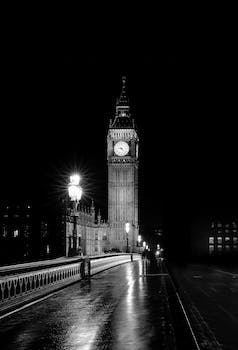

-
Table of Contents
The Tower of London: A Millennium-Old Stronghold
Introduction
The Tower of London is a historic fortress located in central London, England. With a history spanning over a millennium, it has served various purposes throughout the years, including a royal palace, a prison, and a treasury. This iconic landmark has witnessed significant events in British history and is renowned for its architectural grandeur and cultural significance.
The History and Significance of The Tower of London
The Tower of London: A Millennium-Old Stronghold
The Tower of London stands as a testament to the rich history and significance of the British monarchy. This iconic fortress, located on the banks of the River Thames, has witnessed over a thousand years of political intrigue, royal ceremonies, and historical events. Its imposing presence and architectural grandeur make it one of the most visited tourist attractions in the United Kingdom.
The history of the Tower of London dates back to the Norman Conquest of England in 1066. Following his victory at the Battle of Hastings, William the Conqueror ordered the construction of a mighty stone fortress to consolidate his power and protect his newly acquired kingdom. The Tower, initially known as the White Tower, was completed in 1097 and served as a royal residence, a treasury, and a prison.
Throughout the centuries, the Tower of London played a pivotal role in the tumultuous history of England. It became a symbol of royal authority and a place of imprisonment for high-profile figures, including monarchs, nobles, and political prisoners. The infamous Traitors' Gate, a water entrance to the Tower, witnessed the arrival of many prisoners, such as Anne Boleyn, Sir Thomas More, and Guy Fawkes.
The Tower's significance extended beyond its role as a prison. It served as a repository for the Crown Jewels, a collection of precious gemstones and regalia used in royal ceremonies. The Crown Jewels, including the Imperial State Crown and the Sovereign's Sceptre, are displayed in the Jewel House, attracting millions of visitors each year.
Moreover, the Tower of London became a symbol of military might and defense. Its strategic location on the River Thames allowed it to control access to the city of London. The fortress underwent several expansions and fortifications over the centuries, including the addition of defensive walls, towers, and a moat. The medieval defensive system of the Tower, with its formidable battlements and imposing presence, served as a deterrent to potential invaders.
The Tower of London also witnessed significant historical events that shaped the course of British history. It was within these walls that the young princes, Edward V and Richard of Shrewsbury, were famously imprisoned and, according to popular belief, murdered by their uncle, Richard III. The execution of three queens, Anne Boleyn, Catherine Howard, and Lady Jane Grey, also took place within the Tower's confines.
In addition to its historical significance, the Tower of London has become a symbol of British tradition and pageantry. The Ceremony of the Keys, a nightly ritual that has taken place for over 700 years, involves the locking of the Tower's gates and the handing over of the keys to the Chief Yeoman Warder. This ancient ceremony, performed in the presence of the reigning monarch, showcases the Tower's enduring connection to the monarchy.
Today, the Tower of London stands as a UNESCO World Heritage Site and a living museum that offers visitors a glimpse into the past. Its rich history, architectural splendor, and cultural significance make it a must-visit destination for history enthusiasts and tourists alike. As visitors explore the Tower's ancient walls, they are transported back in time, immersing themselves in the stories and legends that have shaped the course of British history.
In conclusion, the Tower of London stands as a millennium-old stronghold that has witnessed the rise and fall of monarchs, the imprisonment of political figures, and the pageantry of royal ceremonies. Its historical significance, architectural grandeur, and cultural importance make it a symbol of British heritage and a testament to the enduring power of the monarchy. As visitors walk through its ancient halls, they are transported back in time, connecting with the rich tapestry of history that the Tower represents.
The Tower of London: A Glimpse into Medieval Architecture

The Tower of London: A Millennium-Old Stronghold
The Tower of London stands as a testament to the rich history and architectural marvels of medieval times. This iconic fortress, located on the banks of the River Thames in central London, has witnessed over a thousand years of British history. Its imposing presence and intricate design make it a must-visit destination for history enthusiasts and architecture aficionados alike.
Built by William the Conqueror in the 11th century, the Tower of London was initially intended as a royal residence. However, it quickly evolved into a symbol of power and authority, serving as a fortress, a royal palace, and a prison. Over the centuries, it has been expanded and modified by various monarchs, resulting in a unique blend of architectural styles.
One of the most striking features of the Tower of London is its defensive structure. The fortress is surrounded by a massive stone wall, punctuated by numerous towers and battlements. These fortifications were designed to withstand attacks and deter potential invaders. The White Tower, the central keep of the fortress, is particularly impressive. Its solid stone walls and imposing presence evoke a sense of strength and resilience.
Inside the Tower, visitors can explore a labyrinth of rooms and corridors, each with its own story to tell. The medieval architecture is evident in the grand halls, narrow staircases, and vaulted ceilings. The Chapel of St. John, located within the White Tower, showcases exquisite Romanesque architecture, with its rounded arches and intricate stone carvings.
As one delves deeper into the Tower's history, the darker side of its past becomes apparent. The Tower of London has served as a prison for many notable figures throughout history, including Anne Boleyn, Sir Walter Raleigh, and Guy Fawkes. The infamous Traitors' Gate, through which prisoners were brought into the Tower, is a chilling reminder of the fortress's role as a place of punishment and execution.
The Tower of London is also home to the Crown Jewels, a dazzling collection of precious gems and regalia. Housed in the Jewel House, these treasures are a testament to the wealth and opulence of the British monarchy. Visitors can marvel at the sparkling crowns, scepters, and orbs, each with its own historical significance.
Despite its tumultuous past, the Tower of London has managed to survive the ravages of time. It has been a witness to countless historical events, from royal coronations to political intrigue. Today, it stands as a UNESCO World Heritage Site and a popular tourist attraction, offering visitors a glimpse into the medieval world.
In conclusion, the Tower of London is a remarkable example of medieval architecture and a living testament to the rich history of Britain. Its imposing structure, intricate design, and fascinating stories make it a must-visit destination for anyone interested in the past. Whether exploring its defensive fortifications, admiring its grand halls, or marveling at the Crown Jewels, a visit to the Tower of London is a journey through time and an opportunity to connect with the legacy of the past.
The Dark Secrets and Intriguing Legends of The Tower of London
The Tower of London, a millennium-old stronghold, stands proudly on the banks of the River Thames in the heart of London. This historic fortress has witnessed countless events throughout its long and storied history, making it a fascinating destination for history enthusiasts and curious visitors alike. However, behind its imposing walls lie dark secrets and intriguing legends that have captured the imagination of people for centuries.
One of the most infamous legends surrounding the Tower of London is the story of the Princes in the Tower. In 1483, two young boys, Edward V and his brother Richard, were imprisoned within the Tower by their uncle, Richard III. The boys were never seen again, and their fate remains a mystery to this day. Some believe they were murdered, while others speculate that they escaped or were hidden away. The mystery surrounding their disappearance has fueled countless theories and has become an enduring part of the Tower's history.
Another dark secret of the Tower is its role as a place of execution. Over the centuries, the Tower has witnessed the deaths of many notable figures, including three queens of England. Anne Boleyn, the second wife of Henry VIII, was famously executed within the Tower's walls in 1536. Lady Jane Grey, the "Nine Days' Queen," also met her end here in 1554. And in 1917, the last person to be executed at the Tower was German spy Josef Jakobs. The Tower's history as a place of death and punishment adds to its aura of mystery and intrigue.
The Tower of London is also home to the Crown Jewels, a dazzling collection of precious gems and regalia. The jewels are kept in the Jewel House, a heavily fortified building within the Tower complex. The Crown Jewels have been used in coronations and other royal ceremonies for centuries, and their display attracts millions of visitors each year. The Jewel House is heavily guarded, with security measures that rival those of a high-security bank vault. The Crown Jewels are a symbol of the monarchy's power and wealth, and their presence within the Tower adds to its allure.
One of the most famous residents of the Tower was the notorious Sir Walter Raleigh. Imprisoned here for 13 years, Raleigh spent his time writing and studying. He is said to have written his famous work, "The History of the World," during his captivity. Raleigh's imprisonment in the Tower is a testament to its role as a place of confinement and punishment throughout history.
The Tower of London has also been the site of numerous ghostly sightings and paranormal experiences. Many visitors and staff members claim to have seen the spirits of former prisoners and executed individuals wandering the Tower's corridors. The most famous ghost is that of Anne Boleyn, who is said to haunt the Chapel of St. Peter ad Vincula, where she was buried after her execution. These ghostly tales add an eerie element to the Tower's already rich history.
In conclusion, the Tower of London is not just a historic fortress; it is a place steeped in dark secrets and intriguing legends. From the mysterious disappearance of the Princes in the Tower to the ghostly apparitions that haunt its halls, the Tower's history is filled with tales that continue to captivate and fascinate. Whether you are interested in history, legends, or the supernatural, a visit to the Tower of London is sure to leave you with a sense of awe and wonder.
Q&A
1. When was the Tower of London built?
The Tower of London was built in the 11th century, specifically in the year 1078.
2. What was the purpose of the Tower of London?
The Tower of London served various purposes throughout history, including being a royal palace, a prison, and a treasury.
3. Is the Tower of London open to the public?
Yes, the Tower of London is open to the public and serves as a popular tourist attraction, allowing visitors to explore its rich history and see the Crown Jewels.
Conclusion
The Tower of London is a millennium-old stronghold that holds great historical significance. It has served various purposes throughout its existence, including being a royal palace, a prison, and a treasury. The Tower has witnessed numerous significant events and has housed many notable prisoners, such as Anne Boleyn and Sir Walter Raleigh. Today, it stands as a popular tourist attraction, offering visitors a glimpse into its rich history and iconic architecture. The Tower of London continues to be a symbol of power and resilience, representing the enduring legacy of England's monarchy.












